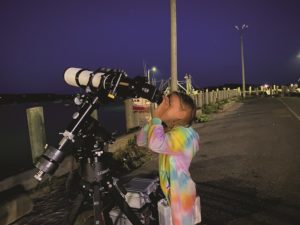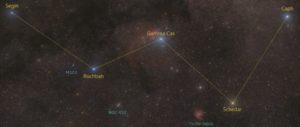A range of signals alert you to each season’s arrival. The changing light, the landscape, the weather, and the amount of traffic on Route 6 all tell the time of year. Did you know that you can look to the night sky in the same way to mark your passage through the seasons? That’s because as Earth orbits the Sun, the backdrop of stars and constellations changes with them.
When Orion strides across the sky after darkness falls, you know it’s winter. When Cygnus the Swan is high overhead, you know it’s summer. And now, as Jupiter and Saturn take center stage, you know it’s autumn.
Jupiter has been in the news recently: the king of the planets is currently at opposition. This astronomical term means that a planet is in the opposite part of the sky from the Sun. If you had an extremely long string, you could trace a straight line from the Sun through the Earth and extend it out to the planet at opposition.

Jupiter is the largest planet in our solar system and always appears as a very bright star. But at opposition, it’s at its brightest. And this opposition is a particularly good one for Jupiter-watchers. Planetary orbits are not perfectly circular. They’re ellipses, which means that a planet’s distance from the Sun varies slightly over time. Right now, the variations in Earth’s and Jupiter’s orbits have aligned in such as a way as to bring us closer to Jupiter than we typically are. The result? Jupiter looks bigger and brighter than ever.
Look for Jupiter in the east-southeastern sky after dark. You’ll see a brilliant golden-white star far outshining everything but the Moon. If you have binoculars, steady them on a railing or tree branch and point them at Jupiter. You’ll see up to four tiny white stars very close to the planet, clearly forming a straight line. Some may be on one side of Jupiter and some on the other.
These are actually not stars but four of Jupiter’s 80 moons: Io, Europa, Ganymede, and Callisto, also called the Galilean moons in honor of Galileo Galilei.
After spending some time with Jupiter, shift your gaze further south (to your right) until you strike a dimmer star with a ruddy-gold color. That’s Saturn. If you have sharp eyes, binoculars may reveal Saturn with an elongated football-like shape, due to its rings. But you’ll need a small telescope to fully resolve the rings.
Two nights ago, I set up my telescope to observe Jupiter and Saturn and invited passersby to look. I began by pointing out the two planets in the sky and then invited people to observe them through the telescope. People ask about their size and about how far away they are. But my favorite questions were: “How do you know that a particular star is Saturn or Jupiter?” and “How did you know tonight would be a good night to see them?”
The answer is that I have learned my way around the sky — and it is not hard to do. You can begin with books like Night Sky: A field guide to the constellations by Jonathan Poppele or The Monthly Sky Guide by Ian Ridpath and Wil Tirion, which take you through the year by highlighting the prominent constellations season by season. You need only to learn a few of them to get your bearings at any time of year.

Those constellations then form a foundation that enables you to readily find the brightest stars, which also vary with the seasons. After that you can expand your sky watching and begin to identify the odd stars that come and go throughout the year on unique and seemingly bizarre paths. Ancient astronomers called them wandering stars, or astra planeta in ancient Greek, from which we derive our word planets.
Once you know something about what’s in the sky at any given time of year, there are a few ways to find them, even without a telescope.
The books I’ve mentioned here have tables that detail when and where to look for the planets. You can also find this information online, or with smartphone apps like Sky Safari or Stellarium, or even almanac-type apps. Whatever reference sources you choose, at a certain point you need to go outside and look at the sky. As you go back and forth between descriptions and real-life observation, you’ll soon come to know what’s in the sky throughout the year.
Which is to say: you can be one of those people who knows when and where to look for the planet Jupiter, the red star Betelgeuse, or the constellation Cassiopeia. Clear skies!



